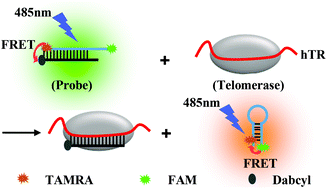A dual-colored ratiometric-fluorescent oligonucleotide probe for the detection of human telomerase RNA in cell extracts†
Abstract
Human telomerase RNA (hTR), which is one component of telomerase, was deemed to be a biomarker to monitor tumor cells due to its different expression levels in tumor cells and normal somatic cells. Thus far, plentiful fluorescent probes have been designed to investigate nucleic acids. However, most of them are limited since they are time-consuming, require professional operators and even result in false positive signals in the cellular environment. Herein, we report a dual-colored ratiometric-fluorescent oligonucleotide probe to achieve the reliable detection of human telomerase RNA in cell extracts. The probe is constructed using a dual-labeled fluorescent oligonucleotide hybridized with target-complemented Dabcyl-labeled oligonucleotide. In the presence of the target, the dual-labeled fluorescent oligonucleotide translates into a hairpin structure, which leads to the generation of the fluorescence resonance energy transfer (FRET) phenomenon under UV excitation. Compared to conventional methods, this strategy could effectively avoid false positive signals, and it not only possesses the advantages of simplicity and high specificity but also has the merits of signal stability and distinguishable color variation. Moreover, the quantitative assay of hTR would have a far-reaching impact on the telomerase mechanism and even tumor diagnosis research.



 Please wait while we load your content...
Please wait while we load your content...